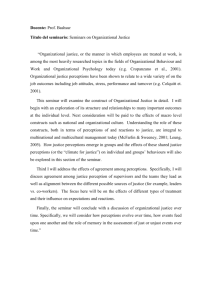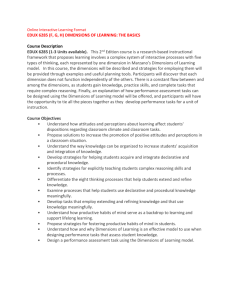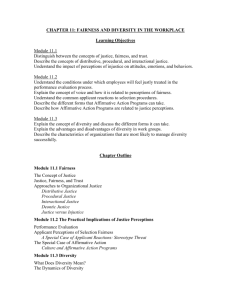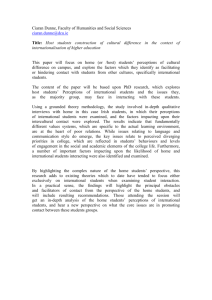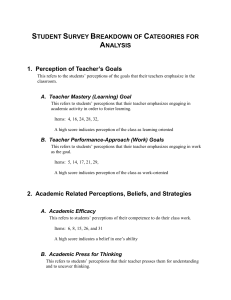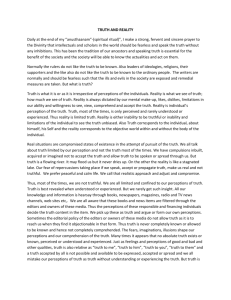organizational justice perceptions
advertisement
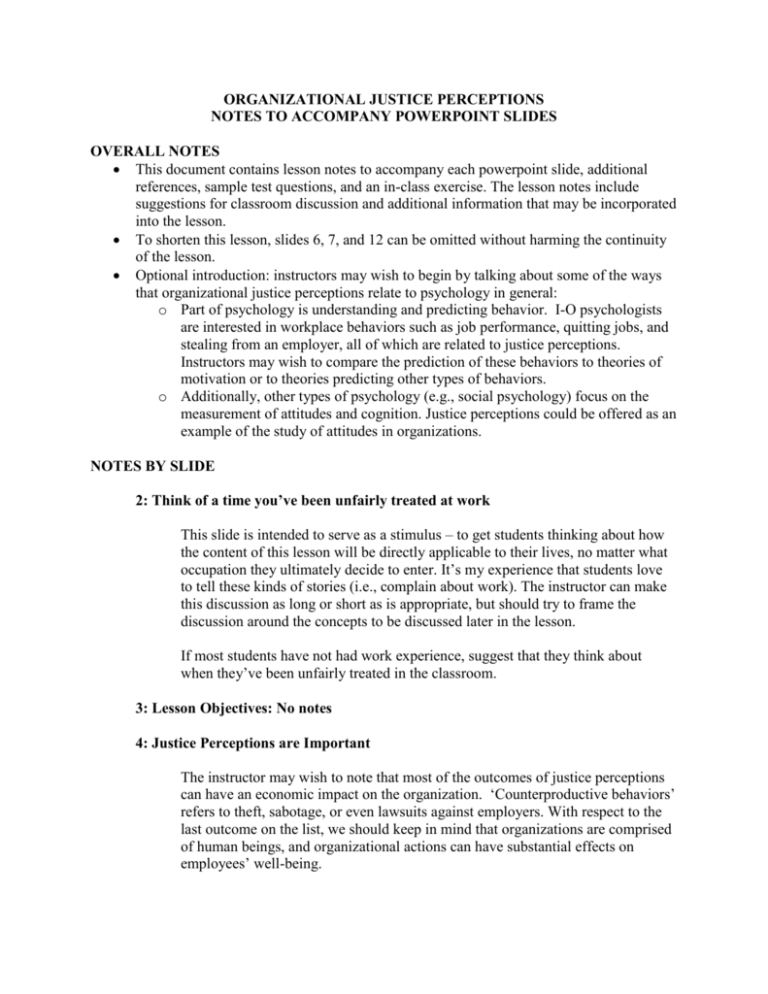
ORGANIZATIONAL JUSTICE PERCEPTIONS NOTES TO ACCOMPANY POWERPOINT SLIDES OVERALL NOTES This document contains lesson notes to accompany each powerpoint slide, additional references, sample test questions, and an in-class exercise. The lesson notes include suggestions for classroom discussion and additional information that may be incorporated into the lesson. To shorten this lesson, slides 6, 7, and 12 can be omitted without harming the continuity of the lesson. Optional introduction: instructors may wish to begin by talking about some of the ways that organizational justice perceptions relate to psychology in general: o Part of psychology is understanding and predicting behavior. I-O psychologists are interested in workplace behaviors such as job performance, quitting jobs, and stealing from an employer, all of which are related to justice perceptions. Instructors may wish to compare the prediction of these behaviors to theories of motivation or to theories predicting other types of behaviors. o Additionally, other types of psychology (e.g., social psychology) focus on the measurement of attitudes and cognition. Justice perceptions could be offered as an example of the study of attitudes in organizations. NOTES BY SLIDE 2: Think of a time you’ve been unfairly treated at work This slide is intended to serve as a stimulus – to get students thinking about how the content of this lesson will be directly applicable to their lives, no matter what occupation they ultimately decide to enter. It’s my experience that students love to tell these kinds of stories (i.e., complain about work). The instructor can make this discussion as long or short as is appropriate, but should try to frame the discussion around the concepts to be discussed later in the lesson. If most students have not had work experience, suggest that they think about when they’ve been unfairly treated in the classroom. 3: Lesson Objectives: No notes 4: Justice Perceptions are Important The instructor may wish to note that most of the outcomes of justice perceptions can have an economic impact on the organization. ‘Counterproductive behaviors’ refers to theft, sabotage, or even lawsuits against employers. With respect to the last outcome on the list, we should keep in mind that organizations are comprised of human beings, and organizational actions can have substantial effects on employees’ well-being. All of these reasons are important given the current economy. Many organizations have been forced to lay people off – were these layoffs perceived as fair by employees? What do the employees who weren’t laid off think? Additionally, some organizations have gone bankrupt, using practices that destroyed the retirement savings of its employees (e.g., Enron). How will these employees react? See Colquitt et al. (2001) for meta-analytic estimates of these (and other) relationships between specific justice dimensions and outcomes. Here, or at some later point in the lesson, it could be discussed how the domain of organizational justice emerged from related research in social psychology, particularly from studies on relative deprivation and in the social psychology of legal phenomena. Several prominent organizational justice researchers were actually trained as social psychologists. See Byrne & Cropanzano, 2001, for a brief history of organizational justice. 5: Types of Justice Perceptions The instructor should mention that ‘justice’ and ‘fairness’ are both used in this literature interchangeably. Research and theory in this domain have been conducted in social psychology as well, but has been applied specifically to organizational contexts by I-O psychologists. NOTE: The precise dimensionality of justice perceptions is still debated. Various contemporary theorists have argued that justice is anything from a single dimension to four dimensions (the missing dimension here is Informational Justice, which refers to the appropriateness of the amount of information you have been provided about the decision and the process; see Colquitt et al., 2001). The present three-dimension typology is similar to that of Folger and Cropanzano (1998), among others. Distributive Justice The ‘outcome’ is usually thought of as some decision that has been rendered regarding the employee. Typical examples include hiring decisions, and the outcomes of performance appraisals, raise requests, decisions about downsizing/layoffs, etc. Example: You apply for a job at a local temp agency with your friend. You believe that you are more qualified than your friend, but your friend is offered the job and you are not. The instructor should emphasize that this perception has to do only with the outcome, not with whether the process behind the decision was unfair. The instructor may choose to ask students why outcomes are fair (i.e., generate rules for deciding distributive justice). For instance, how would you allocate pay raises across a group of employees? What’s the fairest way to allocate health care benefits? Procedural Justice Example: The woman making the hiring decision at the temp agency was your friend’s aunt, so she offered your friend the job even though you were more qualified. The element of procedural fairness that was violated was the consistency of the hiring procedures used (i.e., she bent the rules for her relative). The instructor may choose to have students generate rules for making particular decisions here. Suggestion: What’s the fairest way to distribute tickets for college football games (or whatever sport has hard-to-come-by tickets at your institution). The instructor might want to note that sometimes procedures themselves can be viewed as an outcome, and vice versa (see Cropanzano & Ambrose, 2001), making distinctions between these two aspects of justice somewhat ambiguous at times. 6: Distributive Justice Note: Slides 6, 7, and 12 can be omitted in the interest of time without detracting from the continuity of the lesson. The phrase “allocating resources” refers to situations where the organization has some outcome that can be distributed to some employees (for instance, a certain number of promotions or new jobs, or a certain amount of money that can be allocated for raises or bonuses). Although distributive justice perceptions are merely the perceptions of whether the outcome was fair or not, it has been argued that people use one or more of these rules to decide whether an allocation decision was fair. The distributive justice rules mentioned here have been argued to be used in different types of situations, but there is scant research about when employees use one rule instead of another to evaluate a decision in an organization. Some psychologists have recently argued that one of the factors may be the employee’s culture. For instance, someone from a more ‘collectivist’ culture may be more likely to use an equality rule of justice, especially among members of his or her close work group. Examples Equity Rule: When several employees apply for a promotion, it should be given to the person who is most qualified (that is, the person who has the strongest abilities, or the person who is capable of contributing the most to the organization). Equality Rule: When health benefits are given out, they should be given to all employees, not just those people who are the hardest workers. Need Rule: If an employee has a family emergency, a supervisor might give him or her time off. Note that this time off might contrast with the equity rule in that the needy employee might not necessarily be the person whose job performance has been the best. Most research in Organizational Justice has explored the equity rule. 7: Distributive Justice: Equity Theory Equity Theory was first proposed by Adams (1965). Adams proposed a theory regarding how people arrive at decisions regarding whether a decision was fair. The instructor may wish to illustrate this comparison out as an equation: Employee Inputs ------------------= Employee Outcomes Other’s Inputs -----------------Other’s Outcomes Important Point: If the Other employee is receiving more from the organization (such as getting paid more), the employee won’t think it’s unfair if the Other contributes more to the organization too (by being a better performer, working longer, etc.). If inequity is perceived, the employee may experience emotional reactions (such as anger) as a result. Adams proposed a number of ways that an individual would act to resolve the inequity, but research has not yet clarified when an individual would choose one path instead of another: •Employee could decrease inputs (that is, work slower or more sloppily), thus equating the ratios •Employee could try to get outcomes increased (by asking for a raise) •Employee could try to get Other to work harder, thus equating the ratios •Employee could try to get the Other’s Outcomes reduced (e.g., by squealing) •Employees could choose a different (i.e., more appropriate) Other. Note that this Other might not even be a fellow employee. People could compare themselves to people outside the company (for instance, old friends in the same type of job). •Employees could cognitively distort the comparison they make (e.g., they could end up convincing themselves that they were in an equitable situation when in fact they were not). •Employees could leave the situation (i.e., quit) The above notes focus on situations in which the person was underpaid. Other research has explored what happens when an individual perceives that they have been overpaid (they may increase their productivity to make the situation more equitable, but this effect gradually wears off, possibly because they cognitively reevaluate their inputs to justify the differences in pay). 8: Procedural Justice ‘Voice’ was proposed by Thibaut and Walker (1975), and refers to when individuals (i.e., employees) are given a chance to speak on their own behalf. They distinguished between ‘instrumental’ voice, in which their comments may influence the decision, and ‘noninstrumental’ voice, in which the comments will have no bearing on the outcome (e.g., comments were only allowed after the decision had been made). Various studies have shown both to be effective in various contexts. The other attributes of procedural fairness come from Leventhal (1976; 1980). Consistency: A procedure should be consistent across time and employees Bias Suppression: The decision-maker’s personal biases should not play a role Accuracy: The procedures should be perceived as accurate (e.g., the procedure should correctly identify the person who is most qualified for the job). Correctability: There should be an appeals mechanism in case mistakes are made Ethicality: The decision should be made according to prevailing ethical standards Leventhal did mention one other attribute (Representativeness: all affected parties should be considered when making this decision), but this attribute has been argued to overlap with the construct of ‘voice,’ and it has thus been omitted from the present list. Why does Procedural Justice matter? There are two different theories (see Lind & Tyler, 1988). One proposes that employees use perceptions of the current process to predict how they’ll fare in future encounters with the organization. The other states that employees want to feel that they are part of the organization, and fair procedures are a sign that they are indeed valued and accepted by the organization. 9: When is Procedural Justice Most Important? See Brockner and Weisenfeld (1996), from which the figure is adapted (see p. 191). Main Point: Procedural Justice is more important when the outcome was unfavorable. Or, alternatively, the favorability of the outcome matters more when procedures are perceived as unfair. A good way of summarizing this plot is that “the means justify the ends.” That is, even if the outcome is unfavorable, people will still react well if the procedure was fair. Example of actual research on procedural justice (Brockner et al., 1994, study 3): Brockner et al. (1994) studied 147 employees who knew they were about to be laid off from a “large unionized manufacturing facility in the south central United States.” They were surveyed two months after they found out they were told about the layoff, but one month before they actually stopped working. The positivity / negativity of the outcome was assessed by asking the employees to consider how much other support they had to meet their needs (e.g., unemployment insurance, severance pay, company help with finding another job). The “Reactions” measured in this study was a measure of Organizational Support (questions such as “I am proud to tell others I am a part of ____,” “I would have no problem recommending ______ as an employer to a friend or relative”). The interaction between procedural justice and outcome favorabliity was found (see slide). Note, however, that this graph is specific to reactions to the organization. A related, but different, pattern, exists for the interaction between PJ and Outcome on perceptions of the self (see Brockner, 2002). For instance, people with a negative outcome gained through a process perceived to be fair will experience lower self-esteem than people who receive a negative outcome through an unfair process. 10: Interactional Justice There is some evidence that these two components of interactional justice could be separated into two separate dimensions of justice (e.g., Colquitt, 2001). Bies (2001) provides an in-depth discussion of many factors that could be considered interactional justice (such as the deception of employees or the use of abusive words or actions). 11: Research Example (Greenberg, 1990) See Greenberg (1990) for the report of this interesting study. The pay cut was temporary (about 10 weeks). The inventory of such items as tools and supplies was collected unobtrusively, and factors such as normal use were taken into account. There was also a third plant in the study that served as a control. Theft did not change in this plant over time. Before and after the pay cut, theft in all three plants was similar. It was only while the pay cut was in effect that differences in theft appeared. Note that theft in both plants returned to normal after the pay was returned to normal. 12: Improving Fairness Perceptions In order to improve distributive fairness perceptions, employers can make sure that the situation is perceived as equitable – is the right allocation rule being applied? Will employees see their outcomes/input ratio as equal to others’? In order to improve procedural justice perceptions, employers can make sure that none of the various rules of procedural justice are violated (see slide #8). In order to improve interactional justice perceptions, employers can make sure that employees are given adequate explanations, and that they are treated with sincerity and respect (see slide #10). For the second point (change perceptions of fairness), note that perceptions of fairness can be inaccurate. It is hoped that this line of research can be used to adjust employees’ incorrect perceptions of justice, although this line of research could conceivably be used to make employees think their situation was fair when it actually wasn’t. Additional supplemental points: Folger and Cropanzano’s (1998) Fairness Theory provides a more complex discussion of the mechanisms by which perceptions of justice might be changed (see Chapter 7). The social psychological literature on attribution theory can be integrated here if desired. Some organizational justice researchers (e.g., Ployhart & Ryan, 1997) have begun to look at how attribution theory plays a role in justice judgments and in reactions to organizational decisions. Additionally, students might be interested in how one might measure perceptions of organizational justice in the workplace. Several different scales of organizational justice perceptions exist – see Colquitt, 2001, for an example. For a discussion of justice issues related to layoffs, students may wish to read a recent article in the APA Monitor (Murray, 2002). 13: Summary: No notes REFERENCES Resources to get a basic understanding of organizational justice: Folger, R., & Cropanzano, R. (1998). Organizational justice and human resource management. Thousand Oaks, CA: Sage Publications. This book gives a comprehensive discussion of contemporary justice issues. Instructors wishing to familiarize themselves with the basic issues should read the Preface (pp. xii-xxvi). Colquitt, J. A., Conlon, D. E., Wesson, W. J., Porter, C. O. L. H., & Ng, K. Y. (2001). Justice at the millennium: A meta-analytic review of 25 years of organizational justice research. Journal of Applied Psychology, 86, 425-445. This article is a comprehensive empirical review (183 studies) of relationships between justice and various outcomes. Specific components of procedural justice are examined separately. Greenberg, J., & Cropanzano, R. (Eds.) (2001). Advances in organizational justice. Stanford, CA: Stanford University Press. This book includes advanced discussions of cutting-edge justice issues written by leading justice scholars. Other Works Cited in this Lesson: Adams, J. S. (1965). Inequity in social exchange. In L. Berkowitz (Ed.), Advances in experimental social psychology (Vol. 2, pp. 267-299). New York: Academic Press. Bies, R. J. (2001). Interactional (in)justice: The sacred and the profane. In J. Greenberg & R. Cropanzano (Eds.), Advances in organizational justice (pp. 89-118). Stanford, CA: Stanford University Press. Bies, R. J., & Moag, J. F. (1986). Interactional justice: Communication criteria of fairness. In R. J. Lewicki, B. H. Sheppard, & M. H. Bazerman (Eds.), Research on negotiations in organizations (Vol. 1, pp. 43-55). Greenwich, CT: JAI Press. Byrne, Z. S., & Cropanzano, R. (2001). The history of organizational justice: The founder speak. In R. Cropanzano (Ed.), Justice in the workplace: From theory to practice (Vol. 2, pp. 3-26). Mahwah, NJ: Lawrence Erlbaum Associates. Brockner, J. (2002). Making sense of procedural fairness: How high procedural fairness can reduce or heighten the influence of outcome favorability. Academy of Management Review, 27, 58-76. Brockner, J., Konovsky, M., Cooper-Schneider, R., Folger, R., Martin, C., & Bies, R. J. (1994). Interactive effects of procedural justice and outcome negativity on victims and survivors of job loss. Academy of Management Journal, 17, 397-409. Brockner, J., & Weisenfeld, B. M. (1996). An integrative framework for explaining reactions to decisions: Interactive effects of outcomes and procedures. Psychological Bulletin, 120, 189-208. Colquitt, J. A. (2001). On the dimensionality of organizational justice: A construct validation of a measure. Journal of Applied Psychology, 86, 386-400. Cropanzano, R., & Ambrose, M. L. (2001). Procedural and distributive justice are more similar than you think: A monistic perspective and a research agenda. In J. Greenberg & R. Cropanzano (Eds.), Advances in organizational justice (pp. 119151). Stanford, CA: Stanford University Press. Greenberg, J. (1990). Employee theft as a reaction to underpayment inequity: The hidden cost of pay cuts. Journal of Applied Psychology, 75, 561-568. Leventhal, G. S. (1976). The distribution of rewards and resources in groups and organizations. In L. Berkowitz & W. Walster (Eds.), Advances in experimental social psychology (Vol. 9, pp. 91-131). New York: Academic Press. Leventhal, G. S. (1980). What should be done with equity theory? New approaches to the study of fairness in social relationships. In K. Gergen, M. Greenberg, & R. Willis (Eds.), Social exchanges: Advances in theory and research (pp. 27-55). New York: Plenum. Lind, E. A., & Tyler, T. R. (1988). The social psychology of procedural justice. New York: Plenum. Murray, B. (2002, April). Psychologists help companies traverse the minefields of layoffs. APA Monitor on Psychology, 33, 50-51. Ployhart, R. E., & Ryan, A. M. (1997). Toward an explanation of applicant reactions: An examination of organizational justice and attribution frameworks. Organizational Behavior and Human Decision Processes, 72, 308-335. Thibaut, J., & Walker, L. (1975). Procedural justice: A psychological analysis. Hillsdale, NJ: Erlbaum. SAMPLE TEST QUESTIONS Multiple-Choice Questions: 1._________ refers to the study of perceptions of fairness in the workplace. a.Organizational justice b.Compensatory studies c.Parity d.Synchronization 2. If particular decisions in an organization are made without bias, and are made using the same criteria every time, employees are likely to have positive perceptions of which component of justice? a. Distributive b. Procedural c. Informational d. Interactional 3. If I wanted to maximize the interactional justice in a situation, what would I do? a. Make my employees talk to each other more b. create a peer review system for promotions c. treat my employees with warmth and consideration d. elevate self-awareness Short Answer Question: Your department at work has decided to create the position of Workgroup Leader, which would oversee the employees in each work group and would report to the plant manager. The manager has asked you to create the procedures that would be used to select this new person. Given what you know about Procedural Justice, briefly describe the procedures that you would use. Then, discuss how your procedure used at least three of the components of procedural justice discussed in class. Procedural Justice Exercise Imagine that you are the human resources director at a company that manufactures different types of baseball bats. The company employs approximately 300 people to work on the different machines that produce the varieties of bats. Employees work in groups of about 5-10 people under the supervision of a line manager. Recently, the line managers have been complaining to you about a problem with many employees. Employees haven’t been respecting the line manager – they give snide or rude answers to questions, and they’ve been arriving at work late more often than usual (some people are just not showing up for work). The line managers have asked you to hire employees who have more respect for authority. However, you suspect that the hiring process isn’t the problem. You noticed that these reports of deviant employee behavior first started three months ago. That was right about the time that all employees were given the results of their annual performance review. Thus, you think it’s possible that these employee behaviors may be linked to their reactions to the performance appraisal process, and decide to review the company’s policies on performance appraisal. The current performance appraisal system was put in place 15 years ago. At that time, the company only made one type of bat and only used one kind of machine to do it. Thus, even though employees worked in different groups, they all did exactly the same thing. The company wrote up a single, detailed job description based on how employees were supposed to do their jobs. The performance appraisal is based on this job description. Each step in the job description is used as one part of the performance appraisal process – that is, every employee gets a rating on his or her performance at each step. The appraisals are conducted by the line managers, who rate each of their employees on a 1-5 scale based on how well the employee performs that particular task. In recent years, however, the company has expanded its market into different kinds of baseball bats, which use different machines and processes to produce. Thus, different groups of employees are performing slightly different tasks. Thus, parts of the performance appraisal form don’t always match up to what employees are actually doing. In these cases, the line managers have been told to do the best they can assign ratings on those parts of the form. In order to get employees to take the ratings seriously, all ratings are considered ‘final.’ Questions for Discussion: Which procedural justice rules might employees perceive to have been violated? What would you recommend that the organization do to improve perceptions of the fairness of this process? Notes for the Instructor Regarding the Exercise: Although there may be variability in students’ responses based on the ambiguity of the example, the primary rules that have been violated are accuracy (i.e., the performance appraisal form is based on an outdated job, so parts of it are irrelevant), correctability (i.e., line managers’ decisions are final), and consistency (i.e., since individual line managers have discretion in the interpretation of the performance appraisal form, they may not rate their employees using consistent criteria, and different line managers may rate the same employee differently based on their interpretations of the form). All of these flaws in the system could lead to perceptions of unfairness, and then to deviant employee behaviors. It is anticipated that the students will make several recommendations. Below, you will find some follow-up questions to stimulate the discussion of their recommendations. Accuracy. The students may recommend re-analyzing the job to come up with a more updated performance appraisal. At this point you could discuss how the organization may be unwilling to do this very often, due to the time and money needed. Additionally, in some industries, the nature of the job itself is almost constantly changing (i.e., new machinery may be added frequently). Thus, the ‘new’ form may become quickly outdated too. Regardless of these issues, this is still a good solution. Consistency. Even if the performance appraisal instrument can’t be changed, students may argue that line managers could be made to be more consistent in how they use the instrument. For instance, the HR manager could come up with a strict policy on how to use the form, and train line managers to follow the guidelines. One issue you might bring up with this solution is whether or not the line managers would see this as fair – you are removing some of the discretion they had in doing their jobs, and are forcing them to do it a certain way. Use this example to indicate how many different types of people exist in the organization, and making something fair for one group might increase perceptions of unfairness for another group. Ask students how they would handle explaining this decision to the line managers (watch for procedural and interactional justice principles). Correctability. Students may propose instituting an appeals system. Again, the problems associated with the above issues (i.e., cost, perceptions of fairness from the line manager’s perspective) are relevant. Suppose that the economy isn’t going very well, and the company doesn’t have much money to spend on changing its performance appraisal process. How could the organization handle such a situation? Suggestions could include being careful how to explain the situation to employees, and doing so in a manner to evoke positive perceptions of interactional justice. Make sure you note that the HR directors should not just rely on their own personal impressions of the process. While students may be able to come up with some good ideas about why employees think the procedures are unfair, these perceptions should still be assessed through interviews or surveys.
